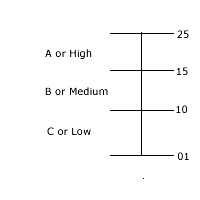Objective
To Identify significant work place hazards and evaluate the risks in order to formulate appropriate control measures for issue to employees so that all employees are aware of the risk to their health and safety and there controls before operations commence.
Definitions
- Hazard: The potential to cause harm. e.g. an unguarded rotary mower blade
- Risk Severity: The gravity of a potential injury or event e.g. amputation of fingers.
- Risk Likelihood: The possibility of an injury or event happening, taking in to account existing workplace conditions, the equipment, the frequency of operation and the number of persons at risk.
- Risk Assessment: A numerical or written word procedure for evaluating and recording Risk Severity and Risk Likelihood in order to obtain an overall assessment of the risks from identified hazards.
- Control Measures: Control measures are the organisational physical or human systems put in place to prevent injury, diseases or infection e.g. safe systems of work, guarding, training and behavioural controls i.e. matching the job and the person. The identification of appropriate control measures is an integral part of the risk assessment and must be seen as the essential end product of the process.
Types of Assessment
There are two assessment formats that are currently in use within the industry namely:
- Generic and
- Local or Site.
The pre-written generic type of risk assessment is not designed to assess the on-going variations that may exist at the workplace.
However they are valid in the grounds maintenance industry when used in conjunction with the more local or site specific assessment. For example, generic assessments can be written for spikers or mowers etc, as the integral hazards of the equipment will not alter. What may alter, however, are the hazards of the locations in which the equipment is used and it is these hazards that must be the subject of local/site specific risk assessment.
The Assessment Process
Identification of hazards
All employees have a duty to observe and report unsafe conditions, systems and work equipment.
Risk Assessment
Employers, have a duty to ensure that an assessment of risk is carried out by themselves or an appointed competent person where a hazard is identified and that suitable and sufficient control measures are put in place.
Method
Having identified a hazard, the risks can be evaluated either using numbers or words to indicate severity or risk values as follows:
Numerical System
If a simple numerical system is used (see example 1) the overall risk factor must be quantified against a pre defined band to obtain the commonly used A, B and C or High, Medium and Low risk categories, for example

Example 1: Numerical Hazard for an unguarded rotary mower blade.
Risk Severity (RS)
- = minor cuts & bruises
- = lacerations strains and sprains
- = amputation or skeletal damage
- = single fatality
- = multiple fatality
Risk Likelihood (RL)
- = improbable
- = feasible
- = possible
- = probable
- = certainty
The identified hazard of (RS) 3 X (RL) 5 = gives a risk factor of 15 which equates to a 'High' or Category 'A 'Risk Value.
This will therefore require the appropriate measures to control the example hazard, such as blade guarding, training and a Safe System of Work.
Written Word System
If a descriptive word assessment is used (see example 2) both the risk severity and the risk likelihood are assessed and quantified by description but are not multiplied to give an overall risk factor.
Nevertheless, it can be identified that if words such as negligible or improbable are chosen to describe a low risk severity or likelihood, then the appropriate control measure can be to monitor the hazard until any changes require a re-assessment.
Example 2: Written Word Hazard for an unguarded rotary mower blade.
Risk Severity
- Negligible = minor cuts & bruises
- Minor = lacerations strains & sprains
- Major = amputation or skeletal damage
- Single fatality
- Multiple fatality
Risk Likelihood
- Improbable
- Feasible
- Possible
- Probable
- Certainty
The identified hazard therefore requires appropriate measures to control the certain risk of amputation or skeletal damage to the operator, such as blade guarding, training and a Safe System of Work.
Note
The evaluation of risk should also take into account the numbers of persons at risk and each assessment should be reviewed annually
